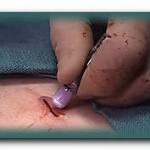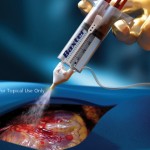STRENGTH AND SECURITY
In less than three minutes, DERMABOND adhesive provides the strength of healed tissue at 7 days. A strong, flexible 3-dimensional bond makes it suitable for use in closing easily approximated incisions of many types (example—deep, short, long).
SEALS OUT BACTERIA

Dermabond forms a layer on top of the wound to seal out bacteria
DERMABOND adhesive is approved to protect wounds and incisions from common microbes that can lead to infection. For trauma and post-surgical patients, infections are often the most common, and in some cases, the most serious complications. DERMABOND adhesive helps protect against the penetration of bacteria commonly associated with surgical site infections. In vitro studies demonstrated that DERMABOND acts as a barrier against Staphylococcus epidermidis, Staphylococcus aureus, Escherichia coli, Pseudomonas aeruginosa and Enterococcus faecium as long as the adhesive film remains intact.
PROMOTES A MOIST, WOUND HEALING ENVIRONMENT
DERMABOND adhesive creates a protective seal and is an occlusive dressing that helps the wound stay moist. Maintaining a moist wound healing environment around the wound has been shown to speed the rate of epithelialization. As the wound heals, DERMABOND adhesive will gradually slough off (generally between 5 to 10 days).
In addition to its surgical adhesive indication, the FDA granted approval in January 2001 for Dermabond to be used as a barrier against common bacterial microbes including certain staphylococci, pseudomonads, and Escherichia coli.
PROVIDES EXCELLENT COSMETIC RESULTS
In a prospective, randomized, controlled, unmasked study of 818 patients, DERMABOND adhesive provided cosmesis equivalent to that of sutures. At 3 months, it produced optimal cosmesis in 80% of patients, using the Modified Hollander Cosmesis Scale.
ADDITIONAL PHYSICIAN AND PATIENT BENEFITS
In most cases, DERMABOND adhesive allows for significantly faster closure than sutures.
DERMABOND adhesive application requires fewer surgical supplies, reduced equipment needs, and eliminates the need for suture removal. DERMABOND adhesive is also more convenient and comfortable for the patient because it often does not require anesthetic, is gentler to the skin than sutures or staples, and does not require suture removal. DERMABOND adhesive also reduces the risk of needle stick injury.
INDICATIONS AND CONTRAINDICATIONS
DERMABOND adhesive is intended for topical application only to hold closed easily approximated skin edges of wounds from surgical incisions, including punctures from minimally invasive surgery, and simple, thoroughly cleansed, trauma-induced lacerations. DERMABOND adhesive may be used in conjunction with, but not in place of, deep dermal sutures. Topical skin adhesives are not appropriate for closing wounds that are subject to significant static or dynamic tensions unless deep sutures,
immobilization, or both are also used.
Fibrin-based tissue adhesives can be created from autologous sources or pooled blood. They are typically used for hemostasis and can seal tissues. Although they do not have adequate tensile strength to close skin, fibrin tissue adhesives can be used to fixate skin grafts or seal cerebrospinal fluid leaks. Commercial preparations such as Tisseel (Baxter) and Hemaseel (Haemacure) are FDA-approved fibrin tissue adhesives made from pooled blood sources. These fibrin tissue adhesives are relatively strong and can be used to fixate tissues. Autologous forms of fibrin tissue adhesives can be made from patient’s plasma. The concentration of
fibrinogen in the autologous preparations is less than the pooled forms; therefore, these forms have a lower tensile strength.
Other materials
Staples provide a fast method for wound closure and have been associated with decreased wound infection rates. Staples are composed of stainless steel, which has been shown to be less reactive than traditional suturing material. The act of stapling
requires minimal skin penetration, and, thus, fewer microorganisms are carried into the lower skin layers. Staples are more expensive than traditional sutures and also require great care in placement, especially in ensuring the eversion of wound edges. However, with proper placement, resultant scar formation is cosmetically equivalent to that of other techniques.
- Closure using adhesive tapes or strips was first described in France in the 1500s, when Pare devised strips of sticking plaster that were sewn together for facial wounds. This method allowed the wound edges to be joined and splinted. The porous paper tapes (eg, Steri-Strips) in use today are reminiscent of these earlier splints and are used to ensure proper wound apposition and to provide additional suture reinforcement. These tapes can be used either with sutures or alone. Often, skin adhesives (eg, Mastisol, tincture of Benzoin) aid in tape adherence.
- Newer products such as the ClozeX (Wellesley, Mass) adhesive strip allows for rapid and effective wound closure that results in adequate cosmesis. Additionally, wound closure with adhesive strips can be significantly cheaper than suturing or using a tissue adhesive. However, adhesive strips are not appropriate for many types of lacerations.

